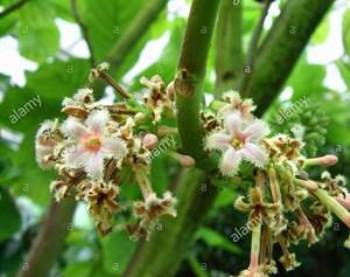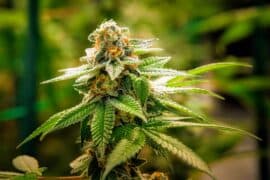Red cinchona
(Melanopsidium nigrum)

Description
Cinchona pubescens, also known as red cinchona and quina (Kina) ((in Spanish) Cascarilla, cinchona; (in Portuguese) quina-do-amazonas, quineira), is native to Central and South America. It is known as a medicinal plant for its bark's high quinine content- and has similar uses to Cinchona officinalis in the production of quinine, most famously used for treatment of malaria. C. pubescens varies from small to large in size, growing to 10 meters in height (33 ft). When cut, the bark tends to turn red. Leaves are elliptical to oblate and thin. The leaves have pubescent teeth that turn red when they are older, hence its nickname the red quinine tree. Its flowers form in large panicles. They are pink and fragrant, while in the Galapagos they are light pink. C. pubescens has the widest distribution of all Cinchona species, with the native range spanning Costa Rica, Panama, Venezuela, Colombia, Ecuador, Peru, and Bolivia. In Ecuador it is distributed within an altitude from 300–3,900 metres (980–12,800 ft). It also grows well in volcanic soil with high nutrient levels. C. pubescens is a resilient species that is able to recover from even extreme damage. If the tree is felled but the stump is left, it can grow back new stalks.If the bark is removed and the xylem is exposed to the elements, the tree will grow the bark back. The tree can even grow back if roots that are left in the ground are larger than 2 cm in diameter. It reproduces rapidly and spreads its seeds via wind. It reaches maturity and begins seeding in 4 years. Growing at a rate of 1–2 m per year, it quickly reaches a tall height where it can shade out the rest of the native plants. Adult trees grow much slower than juveniles. It has become an invasive species where planted outside of its native range, especially on tropical climate islands such as the Galapagos, Hawaii, and Tahiti. In the Galapagos it has become a dominant species in the formerly shrub dominated Miconia and Fern-Sedge zones on Santa Cruz Island.It has been subject to control in the Galapagos National Park to reduce its impacts using a variety of methods. However, controlling it over its total range on Santa Cruz island would cost US$1.65 million according to research done through the Charles Darwin Foundation. According to Jäger et al. 2007, the species richness on Santa Cruz Island, Galapagos Islands has declined by 33% in the Miconia Zone and 10% in the Fern-Sedge Zone since the introduction C. pubescens.
Taxonomic tree:







